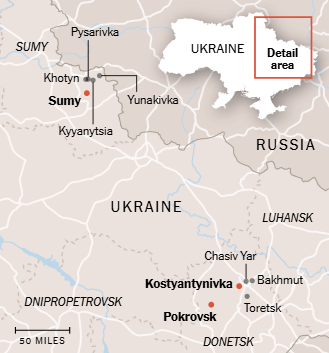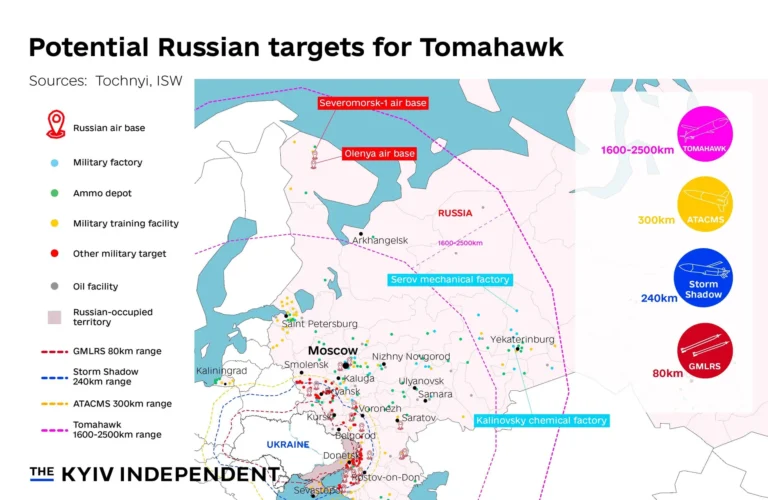
In recent weeks, Russia’s grinding war in Ukraine has entered a dangerous new phase. On the battlefield, Russian forces are advancing on multiple fronts using fast-moving, small-unit tactics, often involving motorcycles and civilian cars, to gain ground in the Donetsk and Sumy regions. Off the battlefield, President Vladimir Putin is signaling a deeper, more totalizing ambition: the belief that all of Ukraine is part of Russia.
This dual-pronged strategy, military escalation and ideological annexation, represents a significant shift in the nature of the conflict and the stakes involved.
The Front Lines: A Summer Offensive with New Tactics
Launched in May, Russia’s summer offensive has already yielded the largest territorial gains in months. According to the Ukrainian group DeepState, Russian forces captured approximately 173 square miles in May, more than double April’s gains. Most of the advance is concentrated in two key areas: south of Kostyantynivka in the Donetsk region and near the Russian border in Sumy.
What sets this offensive apart is a new emphasis on speed and surprise. Russian and Ukrainian troops alike are relying on motorcycles and civilian vehicles to traverse open terrain quickly. “It’s a kind of renaissance of the cavalry, but with internal combustion engines,” noted Colonel Viktor Kevliuk, a reservist and analyst at Ukraine’s Center for Defense Strategies.
Russian tactics involve probing Ukrainian lines with small assault groups, sometimes as few as two or three soldiers, followed by successive waves building on any momentum gained. These tactics are accompanied by increased airstrikes (up from 11 per day in May to 17 in June) and concentrated drone usage to target supply lines.
In Donbas, Russia employs a brutal formula: isolate Ukrainian positions, bombard them with artillery and drones, then send in fast-moving units, often on motorcycles, to strike. The pattern is systematic, ruthless, and designed to stretch Ukraine’s already limited manpower and supplies.
Sumy: A City Under Imminent Threat
One of the key flashpoints is the city of Sumy, home to over 200,000 civilians and located just 12 miles from the Russian front. Russian forces have already captured a dozen nearby villages, moving incrementally with eyes on the city. If they succeed in taking the surrounding settlements, including Khotyn, Yunakivka, Pysarivka, and Kyyanytsia, they may launch a direct assault on Sumy.
While Ukraine benefits from the region’s complex terrain, filled with ravines that limit vehicle movement to roads, Russian troops are pushing toward dense forests that could reduce the effectiveness of Ukraine’s drone surveillance, a troubling development that would require more Ukrainian infantry reinforcements.
Adding to the concern, President Putin explicitly mentioned Sumy during his speech at the St. Petersburg Economic Forum, saying, “We don’t have a goal to grab Sumy… but I don’t exclude it in principle.” His words send a clear message: Russia’s ambitions extend far beyond the four regions it has already declared annexed.
Kostyantynivka: Russia’s Next Big Target
Further south, Russia is focusing efforts on Kostyantynivka, a vital Ukrainian operations hub. The Russian strategy here mirrors that of Sumy: semi-encirclement through multi-directional pressure. Forces are pushing eastward across the T-0504 highway, northward from Toretsk, and westward from Chasiv Yar.
However, this front remains contested. Russian troops have failed to take Chasiv Yar for over two years, and urban warfare in Toretsk is slowing their momentum. Still, Ukrainian commanders warn that Russian forces in some sectors outnumber them 20 to 1, a stark manpower imbalance.
Captain Filatov, a frontline Ukrainian commander, describes a near-constant state of engagement: “A unit of a few dozen typically repels 10 to 15 assaults per week, with as many as four in a single day.”
Putin’s Broader Vision: “The Whole of Ukraine Is Ours”
While Russian forces push forward on the ground, President Putin is also pushing a narrative of imperial reclamation. “Russians and Ukrainians are one people,” he declared in St. Petersburg, “and in that sense the whole of Ukraine is ours.”
He added ominously: “Wherever a Russian soldier steps foot, that’s ours.”
This rhetoric strips away any remaining pretense of limited objectives. It clarifies the Kremlin’s endgame, not just the control of Donetsk, Luhansk, Kherson, and Zaporizhzhia, but the subjugation of Ukraine in its entirety.
Diplomatic Stalemates and Economic Isolation
Despite diplomatic overtures and high-level talks, including at least four public meetings between U.S. and Russian officials this year, little progress has been made. Russia insists that recognition of its claimed territories is a precondition for peace. Ukraine, understandably, rejects this outright.
The Kremlin had hoped that Donald Trump’s return to power in 2024 would lead to a thaw in U.S.-Russia relations. Trump himself once boasted he could end the war in Ukraine “within 24 hours.” But instead of pushing for peace, Trump has now escalated another conflict, ordering airstrikes on Iran’s nuclear facilities on June 21, 2025, and formally entering the Middle East war on the side of Israel. With his diplomatic attention consumed by that crisis, hopes for meaningful mediation in Ukraine have all but vanished.
Meanwhile, the war grinds on. Russian drone attacks on cities like Odesa and Kharkiv continue unabated, and Ukraine, despite heroic resistance, is stretched thin.
Back in St. Petersburg, the annual economic forum has become a ghost of its former self. Once a magnet for Western investment, it is now little more than a domestic propaganda event, with no major American firms present. Russia’s economy, under heavy sanctions and facing 20% interest rates, teeters on the edge of recession.
Conclusion: A War Without Limits
Russia’s summer offensive in Ukraine is more than a seasonal push, it is a full-spectrum strategy that includes territorial conquest, economic brinkmanship, and ideological expansion. From motorcycles on the front lines to bombast on the podium in St. Petersburg, the Kremlin is signaling that it does not intend to stop.
As both Ukraine and its allies weigh their options, one thing is clear: this war is far from over, and Putin’s ambitions are far from satisfied.
Buy Me a Coffee
If you found this analysis helpful and want to support independent writing on Ukraine, global politics, and the fight for democracy, consider buying me a coffee. Every cup helps fuel the research, writing, and late-night fact-checking that goes into posts like this.




